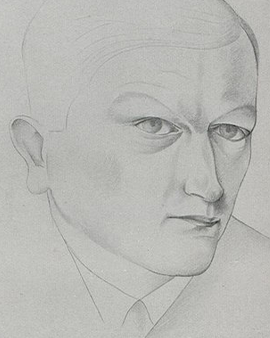


The art scene was enriched on February 13, 1889 by the birth of Georg Gerhard Schrimpf, a painter and graphic artist who has gone down in the annals of art history as one of the most important representatives of New Objectivity. Schrimpf's works exude the essential aesthetics of the time, carefully reproduced by our art prints and made accessible again to a modern audience. Georg Schrimpf, a child with a natural inclination towards art, began drawing enthusiastically at an early age. Despite the lack of understanding and encouragement in his parents' home, Schrimpf learned the art of drawing self-taught and pursued his dream relentlessly. His path took him through many German cities, Belgium and France, where he worked as a waiter, coal shoveler and baker. He developed a deep friendship with the writer Oskar Maria Graf, with whom he traveled through Switzerland and Upper Italy, spending a significant time in an anarchist colony in Ascona/Ticino. It was during this time that the first appreciations of Schrimpf's artistic work by O. M. Graf were written. In 1915 Schrimpf moved to Berlin and, despite his modest existence as a worker in a chocolate factory, began to paint intensively. His first oil paintings, exhibited at the gallery "Der Sturm" thanks to the art expert, gallery owner and publicist Herwarth Walden, met with great acclaim. Schrimpf also began to gain notoriety for his woodcuts for the magazines "Die Aktion" and "Der Sturm".
The moment Georg Schrimpf married the painter and graphic artist Maria Uhden, their artistic synergy became the heart of his creation. Despite the tragic loss of Maria in 1918, Schrimpf continued to create, exhibiting regularly at the Munich Neue Kunst gallery and becoming active in the Munich Räterepublik. Schrimpf's works are characterized by a keen observational ability and an incomparable portrayal of the everyday, which is brought to life through our art prints. The 1930s were a time of contradictions and challenges for Schrimpf. Despite his involvement in the founding and execution of a traveling exhibition of the group "The Seven" and his appointment as an associate professor at the Staatliche Hochschule für Kunsterziehung in Berlin-Schöneberg, he was branded "degenerate" by the Nazi government. His works were removed from German museums, while some of his paintings were paradoxically found in the collections of Nazi greats such as Reich Ministers Hess and Darré.
Schrimpf's untimely death at the age of 49 after his dismissal as a professor in 1937 marked the end of a remarkable career, but one immortalized by his outstanding contributions to art. His artwork - a perfect blend of tenderness, stillness and curiosity - can be found today in our high-quality art prints, which help keep the legacy of this incomparable artist alive.

The art scene was enriched on February 13, 1889 by the birth of Georg Gerhard Schrimpf, a painter and graphic artist who has gone down in the annals of art history as one of the most important representatives of New Objectivity. Schrimpf's works exude the essential aesthetics of the time, carefully reproduced by our art prints and made accessible again to a modern audience. Georg Schrimpf, a child with a natural inclination towards art, began drawing enthusiastically at an early age. Despite the lack of understanding and encouragement in his parents' home, Schrimpf learned the art of drawing self-taught and pursued his dream relentlessly. His path took him through many German cities, Belgium and France, where he worked as a waiter, coal shoveler and baker. He developed a deep friendship with the writer Oskar Maria Graf, with whom he traveled through Switzerland and Upper Italy, spending a significant time in an anarchist colony in Ascona/Ticino. It was during this time that the first appreciations of Schrimpf's artistic work by O. M. Graf were written. In 1915 Schrimpf moved to Berlin and, despite his modest existence as a worker in a chocolate factory, began to paint intensively. His first oil paintings, exhibited at the gallery "Der Sturm" thanks to the art expert, gallery owner and publicist Herwarth Walden, met with great acclaim. Schrimpf also began to gain notoriety for his woodcuts for the magazines "Die Aktion" and "Der Sturm".
The moment Georg Schrimpf married the painter and graphic artist Maria Uhden, their artistic synergy became the heart of his creation. Despite the tragic loss of Maria in 1918, Schrimpf continued to create, exhibiting regularly at the Munich Neue Kunst gallery and becoming active in the Munich Räterepublik. Schrimpf's works are characterized by a keen observational ability and an incomparable portrayal of the everyday, which is brought to life through our art prints. The 1930s were a time of contradictions and challenges for Schrimpf. Despite his involvement in the founding and execution of a traveling exhibition of the group "The Seven" and his appointment as an associate professor at the Staatliche Hochschule für Kunsterziehung in Berlin-Schöneberg, he was branded "degenerate" by the Nazi government. His works were removed from German museums, while some of his paintings were paradoxically found in the collections of Nazi greats such as Reich Ministers Hess and Darré.
Schrimpf's untimely death at the age of 49 after his dismissal as a professor in 1937 marked the end of a remarkable career, but one immortalized by his outstanding contributions to art. His artwork - a perfect blend of tenderness, stillness and curiosity - can be found today in our high-quality art prints, which help keep the legacy of this incomparable artist alive.
Page 1 / 1






